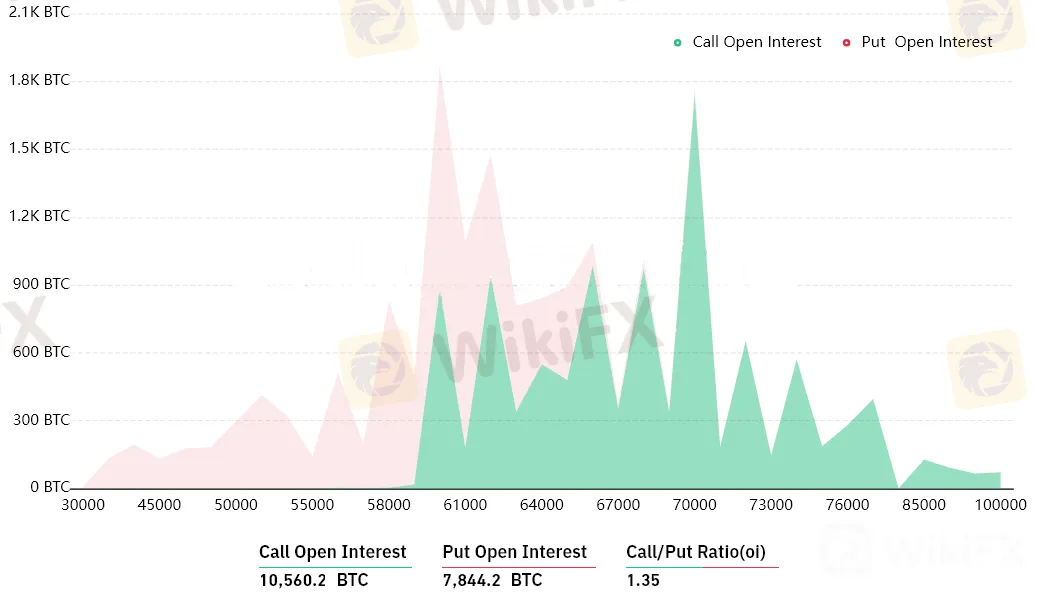简体中文
繁體中文
English
Pусский
日本語
ภาษาไทย
Tiếng Việt
Bahasa Indonesia
Español
हिन्दी
Filippiiniläinen
Français
Deutsch
Português
Türkçe
한국어
العربية
Here’s why bears hope to pin Bitcoin under $60K ahead of Friday’s $1.1B options expiry
Abstract:Last week, bulls had a $715 million advantage when Bitcoin price was above $68,000, but the current downturn gives bears a chance to turn the tables.

Bitcoin (BTC) bulls were euphoric when the price soared to $69,000 on Nov. 10 because the 14.5% gain accumulated over five days meant they were in for a $715 million profit on Nov. 12's options expiry.
However, the 9% negative price move on Nov. 16 caught bulls by surprise, especially since most of the call (buy) options for Nov. 19 have been placed at $66,000 or higher. Curiously, that price level has been the exception rather than the norm.
Bears might have been lucky because the two negative events happened in the past few days. On Nov. 12, the United States Securities and Exchange Commission denied VanEcks spot Bitcoin ETF request. But more important than the rejection, itself, which was largely expected, was the rationale behind the decision.
The SEC explicitly mentioned their uncertainties about Tether‘s (USDT) stablecoin and the lack of ability to deter fraud and market manipulation in Bitcoin trading. Bloomberg senior ETF analyst and cryptocurrency expert Eric Balchunas had already given a 1% chance for approval so the denial wasn’t really a surprise.
Moreover, on Nov. 15, U.S. President Joe Biden sanctioned the infrastructure bill, which mandates that starting in 2024, digital asset transactions worth more than $10,000 be reported to the Internal Revenue Service.
Considering the above scenario, bulls are likely to regret their lack of more conservative bets on Nov. 19s $1.1-billion weekly options expiry.
At first sight, the $630 million call (buy) options dominate the weekly expiry by 35% compared to the $470 million put (sell) instruments. Still, the 1.35 call-to-put ratio is deceptive because the recent price crash will probably wipe out most bullish bets.
For example, if Bitcoin‘s price remains below $62,000 at 8:00 am UTC on Nov. 19, only $68 million worth of those call (buy) options will be available at the expiry. For example, there is no value in the right to buy Bitcoin at $64,000 if it’s trading below that price.

Bears have their eyes set on prices below $60,000
Listed below are the four most likely scenarios for the $1.1-billion Nov. 19 expiry. The imbalance favoring each side represents the theoretical profit. In other words, depending on the expiry price, the quantity of call (buy) and put (sell) contracts becoming active varies:
Between $58,000 and $60,000: 10 calls vs. 3,840 puts. The net result is $220 million favoring the put (bear) options.
Between $60,000 and $62,000: 910 calls vs. 1,950 puts. The net result is $60 million favoring the put (bear) instruments.
Between $62,000 and $64,000: 2,030 calls vs. 940 puts. The net result is $70 million favoring the call (bull) options.
Above $64,000: 2,920 calls vs. 240 puts. The net result is $175 million favoring the call (bull) instruments.

This crude estimate considers call options being used in bullish bets and put options exclusively in neutral-to-bearish trades. However, this oversimplification disregards more complex investment strategies.
For instance, a trader could have sold a put option, effectively gaining a positive exposure to Bitcoin (BTC) above a specific price. But, unfortunately, theres no easy way to estimate this effect.
Bulls need a 6% price hike to turn the tables
The only way for bulls to profit a significant amount on Nov. 19‘s expiry is by pushing Bitcoin’s price above $64,000, which is 6% away from the current $60,400. If the current short-term negative sentiment prevails, bears could exert some pressure and try to score up to $220 million in profit if Bitcoin price stays closer to $58,000.
Currently, options markets data slightly favor the put (sell) options, slightly reducing the odds of a rally ahead of Nov. 19.
Disclaimer:
The views in this article only represent the author's personal views, and do not constitute investment advice on this platform. This platform does not guarantee the accuracy, completeness and timeliness of the information in the article, and will not be liable for any loss caused by the use of or reliance on the information in the article.
Read more

Ripple Secures Dubai License: First Blockchain Payments Provider in DIFC
Ripple gains Dubai regulatory license, becoming the first blockchain payments provider in DIFC, boosting crypto innovation in the UAE.

Bybit CEO Warns Against Risks of Pi Network for Lack of Transparency
Bybit's Ben Zhou highlights the dangers of Pi Network, emphasizing transparency issues and the risks of crypto trading for inexperienced users.

Why Is OKX Crypto Exchange Under EU Probe After Bybit $1.5B Heist?
Why is OKX crypto exchange probed by EU after Bybit’s $1.5B heist? Explore MiCA’s role, OKX’s Web3 service, and crypto security challenges.

Coinbase Launches 24/7 Bitcoin and Ethereum Futures Trading
Coinbase introduces 24/7 Bitcoin and Ethereum futures trading for U.S. traders, offering perpetual futures contracts with CFTC approval.
WikiFX Broker
Latest News
Beware: Forex Investment Fraud Targeting Low Income Earners
Central Bank Policies,Forex Markets and Gold Prices
These 24 Crypto Scams Are Accelerating the Theft of Your Assets
49 Foreigners Arrested in Illegal POGO Raid in Pasay City
Beware of Fake 'Educational Foundations' Targeting Crypto Investors, Warns North Dakota Regulator
We Asked Grok About Illegal FX Brokers—Here’s What It Revealed
Exposing Trading Academy Scams: How Aspiring Traders are at Risk
Online Investment Scams on the Rise: How Two Victims Lost Over RM100K
Vanished Savings: How One Woman Lost RM412,443 to an Online Scam
Investor Alert: FCA Exposes 9 Unregistered Financial Companies
Currency Calculator







